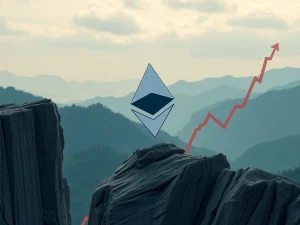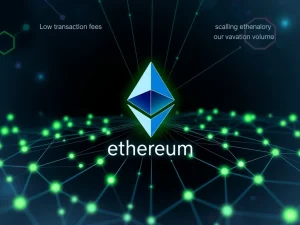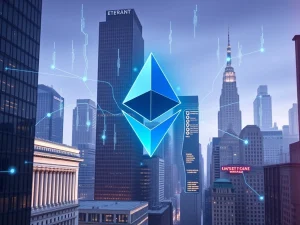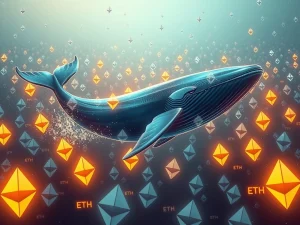Ethereum Fusaka Upgrade: A Pivotal Step Towards Unprecedented Scalability

The cryptocurrency world constantly seeks innovation. Consequently, a major development recently unfolded for Ethereum, the leading smart contract platform. The **Ethereum Fusaka upgrade** has officially gone live on the Sepolia testnet. This significant activation marks a crucial phase in Ethereum’s journey towards greater efficiency and **Ethereum scalability**. For those invested in the future of decentralized applications, this news signals a powerful advancement. It brings the network closer to its anticipated December **mainnet launch**, promising a more robust and capable blockchain for everyone.
Ethereum Fusaka Upgrade Activates on Sepolia
Ethereum’s Fusaka upgrade now operates on the Sepolia testnet. This move represents a vital progression in the network’s ongoing efforts. Its goal is to significantly improve both scalability and overall performance. The activation on Sepolia is actually the second phase of a comprehensive three-step rollout. This roadmap guides Ethereum’s Fusaka initiatives. The journey began with the Holesky testnet activation, which occurred on October 1. Now, Sepolia takes center stage. This deployment focuses specifically on stress testing. It rigorously evaluates the network’s innovative data-availability system. Additionally, it tests the newly increased block gas limit. These crucial tests happen before developers push the refined code. That final step will occur on the Hoodi testnet later this month.
Stress Testing for Enhanced Ethereum Scalability
The Fusaka rollout introduces a suite of important performance and consensus improvements. The full upgrade aims to dramatically increase Ethereum’s block gas limit. It targets a new capacity of 60 million. This higher limit allows blocks to process a greater volume of transactions. It also supports more complex smart-contract activity. Simultaneously, developers are carefully testing node stability. They ensure the network can maintain integrity at these significantly higher capacities. Gabriel Trintinalia, a protocol engineer at Consensys’ client Besu and a core developer for the upgrade, highlighted the team’s dedication. He stated, “There was solid engineering work by the client teams to ensure that the current node setups, both in terms of hardware and networking, can reliably handle 60M gas blocks without risking networking instability.” Since larger blocks inherently require nodes to process and store more data, a new system is also undergoing rigorous testing. This system is called Peer Data Availability Sampling, or **PeerDAS**.
Unveiling PeerDAS: Revolutionizing Data Availability
PeerDAS represents a groundbreaking advancement for Ethereum. This innovative system lets Ethereum validators verify transaction data in a new way. Instead of downloading every piece of information, they sample small pieces. These samples come from multiple peers across the network. This method dramatically improves speed and scalability. Crucially, it achieves this while maintaining decentralization. Paul Harris, another Fusaka core developer and a protocol engineer at Consensys’ Teku client, explained its profound impact. He noted that under PeerDAS, validators no longer need to store all network data. This change significantly reduces the operational burden on individual nodes. Harris further emphasized, “Fusaka changes how data availability is done, enabling scaling beyond what was possible before PeerDAS.” This fundamental shift promises a more efficient and accessible validation process for all participants. It addresses a core challenge in blockchain expansion.
The Road to Mainnet: Fusaka’s December Launch
The Ethereum Foundation outlined the Fusaka testnet schedule on September 26. This announcement detailed the final crucial steps. These steps lead directly to the network’s next major upgrade. Fusaka follows this year’s Pectra update. Its final trial on the Hoodi testnet is set for October 28. Following successful testnet phases, the highly anticipated **mainnet launch** is expected in December. This phased approach ensures thorough testing and refinement. It minimizes risks before deploying significant changes to the live network. The meticulous planning underscores the development team’s commitment. They aim to deliver a stable and powerful upgrade. Users and developers alike eagerly await these improvements. They will unlock new possibilities for the Ethereum ecosystem. The consistent progression reflects a strong dedication to the platform’s long-term vision.
A Legacy of Innovation: Ethereum’s Upgrade History
Since its inception in July 2015, the Ethereum network has continuously evolved. It has undergone several major upgrades. Each one aimed to enhance scalability, security, and performance. The most recent significant review took place on May 7. This was when the Pectra upgrade went live. Pectra introduced three key improvement proposals. Among these changes, it allowed externally owned accounts (EOAs) to function more like smart contracts. They could also pay gas fees using tokens other than ETH. The upgrade further raised the validator staking cap. This increased it to 2,048 ETH from the previous 32 ETH. Pectra also expanded the number of data blobs allowed per block. This directly built upon earlier advancements.
Before Pectra, Ethereum rolled out the Dencun upgrade. This crucial update launched on March 13, 2024. Dencun drastically reduced the cost of gas fees across the network. Within just one year of its implementation, average gas fees on Ethereum dropped significantly. They fell by as much as 95%. This improvement made the network far more accessible. It reduced transaction costs for countless users. Such continuous refinement showcases Ethereum’s dedication to user experience and efficiency.

Perhaps the most famous Ethereum upgrade is known as The Merge. This monumental event occurred in September 2022. It successfully transitioned Ethereum from a proof-of-work (PoW) blockchain to a proof-of-stake (PoS) consensus mechanism. The Merge effectively ended energy-intensive mining. It introduced a system of validators instead. This change resulted in a dramatic reduction in energy costs. Estimates suggest savings of up to 99%. This shift marked a critical step towards a more sustainable blockchain future.

The Shanghai upgrade, which happened in April 2023, was also a pivotal moment. It completed Ethereum’s transition to proof-of-stake. Crucially, it allowed validators staking Ether (ETH) to make withdrawals for the very first time. This feature had been a long-awaited component of the PoS roadmap. It significantly enhanced validator confidence and participation. These historical upgrades collectively pave the way. They enable the advancements seen in the **Ethereum Fusaka upgrade** today. Each step builds upon the last, driving the network forward.
Impact on the Ecosystem and Future of Ethereum
The activation of the **Ethereum Fusaka upgrade** on Sepolia holds immense promise. It directly impacts the entire Ethereum ecosystem. For developers, higher gas limits mean more complex and efficient dApps. These applications can handle greater user loads. They can also execute more sophisticated smart contract logic. For users, the underlying improvements from PeerDAS and increased capacity translate into tangible benefits. Expect potentially faster transaction confirmations. Also, anticipate greater network reliability. These advancements further solidify Ethereum’s position. It remains a leading platform for decentralized finance (DeFi), NFTs, and Web3 innovations. The continuous focus on **Ethereum scalability** ensures the network can meet growing global demand. While Wall Street might express skepticism about a ‘supercycle,’ Ethereum’s core development remains robust. The dedicated engineering work by client teams is evident. They are ensuring stability even at increased capacities. This methodical approach inspires confidence. It points to a resilient and adaptable blockchain future. The **mainnet launch** in December will undoubtedly be a milestone, showcasing years of dedicated development. Ethereum’s journey of improvement continues, driven by innovation and community effort.









